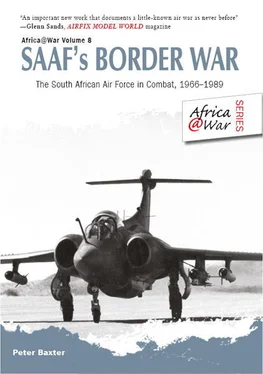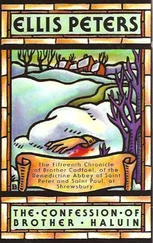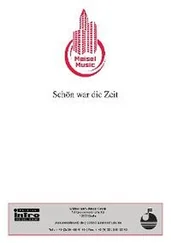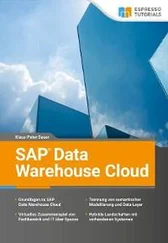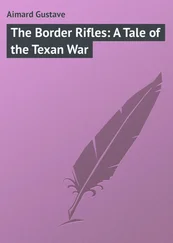Peter Baxter - SAAF's Border War
Здесь есть возможность читать онлайн «Peter Baxter - SAAF's Border War» весь текст электронной книги совершенно бесплатно (целиком полную версию без сокращений). В некоторых случаях можно слушать аудио, скачать через торрент в формате fb2 и присутствует краткое содержание. Город: Solihull, Год выпуска: 2013, ISBN: 2013, Издательство: Helion & Company, Жанр: military_history, на английском языке. Описание произведения, (предисловие) а так же отзывы посетителей доступны на портале библиотеки ЛибКат.
- Название:SAAF's Border War
- Автор:
- Издательство:Helion & Company
- Жанр:
- Год:2013
- Город:Solihull
- ISBN:978-1-908916-23-5
- Рейтинг книги:3 / 5. Голосов: 1
-
Избранное:Добавить в избранное
- Отзывы:
-
Ваша оценка:
- 60
- 1
- 2
- 3
- 4
- 5
SAAF's Border War: краткое содержание, описание и аннотация
Предлагаем к чтению аннотацию, описание, краткое содержание или предисловие (зависит от того, что написал сам автор книги «SAAF's Border War»). Если вы не нашли необходимую информацию о книге — напишите в комментариях, мы постараемся отыскать её.
SAAF's Border War — читать онлайн бесплатно полную книгу (весь текст) целиком
Ниже представлен текст книги, разбитый по страницам. Система сохранения места последней прочитанной страницы, позволяет с удобством читать онлайн бесплатно книгу «SAAF's Border War», без необходимости каждый раз заново искать на чём Вы остановились. Поставьте закладку, и сможете в любой момент перейти на страницу, на которой закончили чтение.
Интервал:
Закладка:
The simple facts of the situation are thus: the Portuguese had for some time been losing ground militarily in all three major African theatres, in particular in Mozambique, with a discernible discontent and lethargy affecting the armed forces as the death toll mounted and territorial losses accrued. To many in the ranks of the Exército Português , the army, upon whom the brunt of attrition was focused, the economic and human cost of attempting to retain control of Portugal’s overseas territories was simply too high. The government was therefore toppled in a leftist military coup on 25 April 1974, with the abrupt ending of all colonial wars becoming perhaps the highest item on the new national agenda.
Independence for Mozambique and Angola was not immediate, but it was de facto upon the formality of a negotiated, and rushed, handover. This left very little time for those with an interest in the outcome of the process to try and influence it. For Rhodesia and South Africa the prospect of a communist takeover in two such vast entities as Mozambique and Angola was unnerving in the extreme, but on a broader stage the Cold War ramifications of such a power vacuum energized both the United States and the Soviet Union – including Cuba as a nominal proxy of the USSR – to act.
In practical terms the matter of a power vacuum tended to affect Mozambique less than it did Angola. There was no doubt that FRELIMO would assume power in Mozambique, and with the Castroesque Samora Machel at the helm of government, its Marxist orientation was also never in doubt. In Angola, on the other hand, the future remained to be settled, be it by negotiation or war, with the latter being the preferred option of each faction if the former failed. With understandable pragmatism, all sides tended to settle on the notion that an expanded war in the region was not only inevitable but in some ways desirable too. (Holden Roberto, leader of the FNLA and a brother-in-law of Zaire’s Mobuto, retained the position, rhetorically at least, that his ambition extended no further than an independent baKongo homeland in the north of Angola.)
Of the two superpowers it was the Soviet Union which was quicker off the mark, arriving in the region ahead of the United States with its support of the MPLA, the most left-leaning of all three of the Angolan revolutionary movements and the one centred on the capital Luanda, which tended to give it the best chance of ultimately seizing power.
The United States, extremely gun-shy in the aftermath of events in Vietnam, was very reluctant to commit troops to southern Africa and felt more inclined to solicit the help of South Africa, an ideological if not a political ally, in influencing events on the ground to the benefit of the West. At the time this was music to South African ears and, although militarily not quite as muscular as it would later become, the South African government felt confident that something practical could be achieved. This, in simple terms, was the backdrop to Operation Savannah , the first unequivocal plunge by the South African military establishment into war in Angola.
US diplomat and Assistant Secretary of State for African Affairs from 1981 to 1989, Chester Crocker, defined the situation on the ground extremely well as Angola began to count down the days to the agreed date of independence from Portugal.
By November 11, 1975, the date of independence, Angola had been effectively thrown to the wolves and a feeding frenzy was underway. Cuban, South African and Zairean combat troops had intervened directly. Mercenaries, advisers and air force and armour crews were engaged from such countries as Algeria, Britain, China, Cuba, France, the Netherlands, Portugal, South Africa, West Germany, the Soviet Union and the United States. Arms and financial support came principally from France, the United States, China, Czechoslovakia, Cuba, Belgium, Nigeria, South Africa, Saudi Arabia and the USSR. The interventions came from land, sea and air; Angola’s notional ‘territorial integrity’ was violated from the Atlantic and from facilities in Zaire, Congo, Guinea, Guinea-Bissau, Mali, Zambia and South Africancontrolled Namibia. [7] Crocker, Chester. High Noon in Africa: Making Peace in a Rough Neighbourhood , Jonathan Ball, Johannesburg, 1992, p. 46.
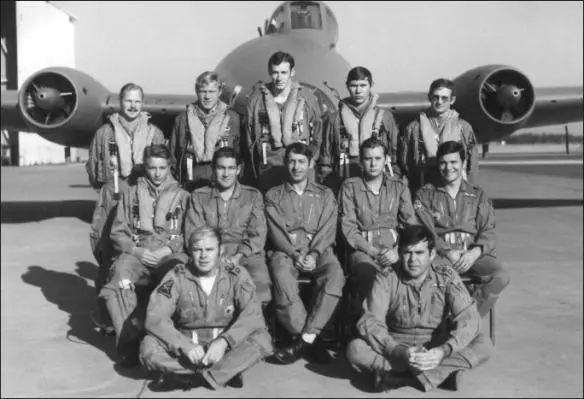
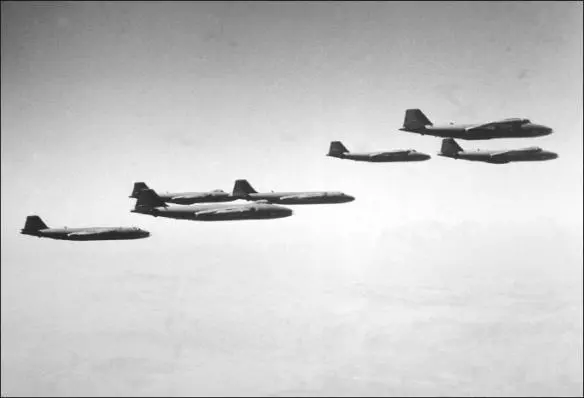
The rationale behind the South African decision to get involved in this Gordian knot to the extent that it was not obvious lies beyond the scope of this narrative. Suffice to say that in early August 1975, at a time more or less corresponding with the arrival in Angola of several thousand Cuban troops, MPLA forces aggressively began to move southward along the coast, in due course threatening the Ruacana–Calueque hydroelectric complex, a joint Angolan–South African venture and a vital water-supply project for the arid and underdeveloped Owamboland region of South West Africa. Part of the facility was inside Angola and, once South African technical staff began to be menaced, the SADF responded by moving 50 kilometres in-country and forcefully occupying the town of Calueque.
This was in early August 1975. At midnight on 15 October the SADF Task Force Zulu, the first of a number of battle groups that would in due course become involved, and comprising Alpha and Bravo groups, crossed from South West Africa into Cuando Cubango, Angola, ostensibly in support of the pro-West FNLA and UNITA, but in effect to roll back the significant territorial advances being made by the MPLA and, moreover, to attempt to affect the outcome of the internal power struggle in the country prior to the date of independence. The decision was made to some extent in spite of deep misgivings felt by Prime Minister John Vorster – or this is at least what was widely reported – but based also on considerable pressure being applied to South Africa from such friendly African governments as Côte d’Ivoire, Zaire and Zambia, and an ‘understanding’ on the matter reached with the United States. [8] Both Alpha and Bravo comprised companies of indigenous troops, in the first instance drawn from elements of the FLNA inducted into the SADF, and in the second by Angolan Bushmen who had suffered significant attrition at the hands of each of the Angolan warring parties at one time or other, and who were at the very least an enigmatic force in the conflict.
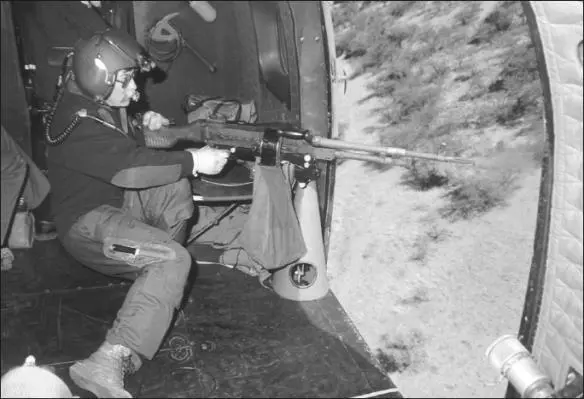

By any standards the advance of the combined South African force northward into Angola ranks as one of the great epics of mobile warfare in Africa, not dissimilar to the comprehensive Allied rout of the Italians in Somalia and Ethiopia during the East Africa Campaign of the Second World War, during which, incidentally, large numbers of South African troops and armoured and air force assets also took part. An ambulating and apparently unstoppable two-pronged advance saw the South Africans move north over vast swathes of Angolan territory, mounted in many instances in an assortment of requisitioned refugee transports, Eland armoured cars, Unimogs and Land Rovers, and aside from a handful of stirring actions, encountering very little organized resistance. In 33 days the SADF advanced an extraordinary 3,159 kilometres, engaging in 30 attacks and 21 skirmishes, killing a conservative tally of 210 enemy troops, wounding a further 96 and securing some 56 captures, weighed against the loss of five South African soldiers and 41 wounded. This, bearing in mind that most fighting men involved were irregulars, was an astonishing achievement. [9] Stiff, Peter. The Silent War: South African Recce Operations 1969–1994 , Galago, Johannesburg, 1999, pp. 120–1.
Интервал:
Закладка:
Похожие книги на «SAAF's Border War»
Представляем Вашему вниманию похожие книги на «SAAF's Border War» списком для выбора. Мы отобрали схожую по названию и смыслу литературу в надежде предоставить читателям больше вариантов отыскать новые, интересные, ещё непрочитанные произведения.
Обсуждение, отзывы о книге «SAAF's Border War» и просто собственные мнения читателей. Оставьте ваши комментарии, напишите, что Вы думаете о произведении, его смысле или главных героях. Укажите что конкретно понравилось, а что нет, и почему Вы так считаете.
